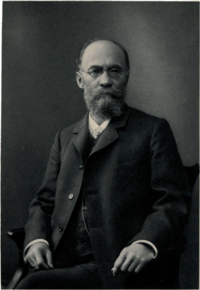Karl Brugmann
| Karl Brugmann | |
|---|---|
 |
|
| Born |
16 March 1849 Wiesbaden |
| Died | 29 June 1919 (aged 70) Leipzig |
| School | Neogrammarian |
|
Main interests
|
Indo-European studies |
|
Influences
|
|
| Signature | |
Karl Brugmann (16 March 1849 – 29 June 1919) was a German linguist. He is noted for his work in Indo-European linguistics.
He was educated at the universities of Halle and Leipzig. He taught at the gymnasium at Wiesbaden and at Leipzig, and in 1872-77 was assistant at the Russian Institute of Classical Philology at the latter. In 1877 he was lecturer at the University of Leipzig, and in 1882 became professor of comparative philology there. In 1884 he took the same position at the University of Freiburg, but returned to Leipzig in 1887 as successor to Georg Curtius; for the rest of his professional life (until 1919), Brugmann was professor of Sanskrit and comparative linguistics there.
As a young man, Brugmann sided with the emerging Neogrammarian school, which asserted the inviolability of phonetic laws (Brugmann's law) and adhered to a strict research methodology. As well as in laying stress on the observation of phonetic laws and their operation, it emphasized the working of analogy as an important linguistic factor in modern languages.
As joint editor with Curtius of The Studies in Greek and Latin Grammar, he wrote an article for this work on “Nasalis Sonans,” in which he defended theories so radical that Curtius afterward disclaimed them. Brugmann's fame rests on the two volumes on phonology, morphology, and word formation which he contributed to the five-volume Grundriss der vergleichenden Grammatik der indogermanischen Sprachen (“Outline of the Comparative Grammar of the Indo-Germanic Languages”), published from 1886 to 1893. The other three volumes were written by Berthold Delbrück and provided a still-unsurpassed account of Proto-Indo-European syntax. Brugmann's work overflowed the bounds assigned to it, so the first volume was split into two parts. With the indexes split off into a separate volume, the two volumes turned into four.
...
Wikipedia
